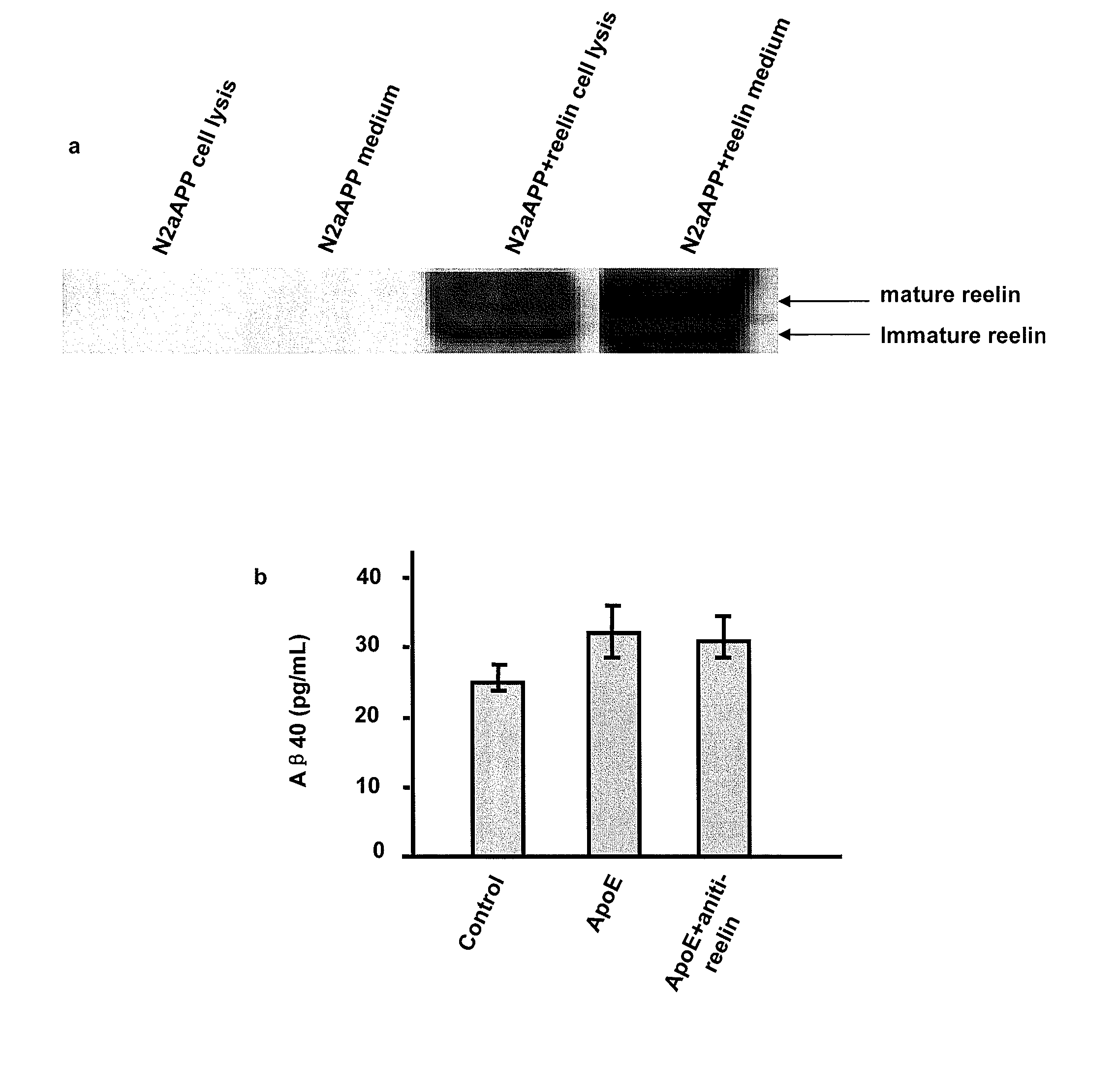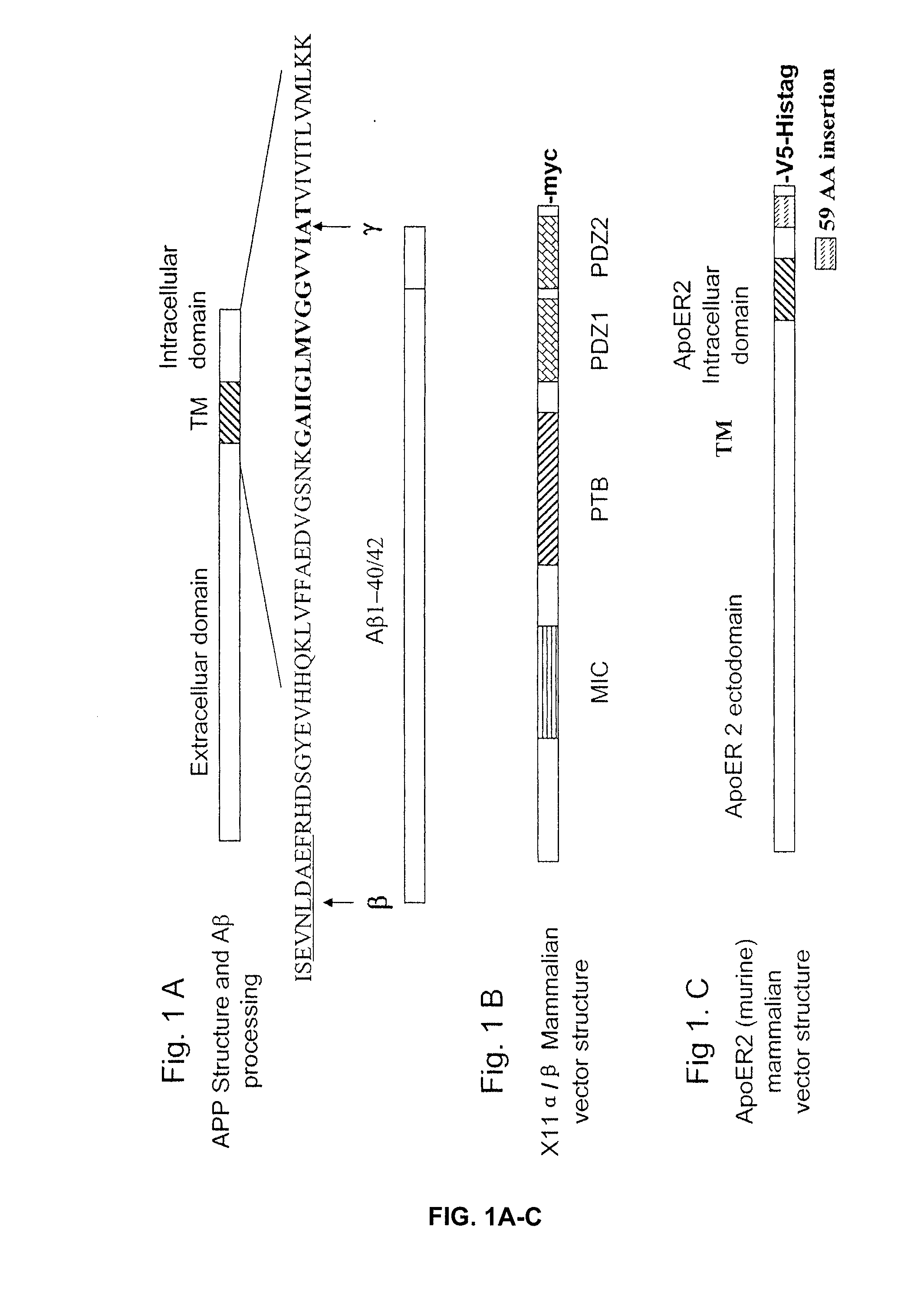Treatment of alzheimer's disease with inhibitors of apoe binding to apoe receptor
a technology of apoe and receptor, which is applied in the field of neuropathology and molecular biology, can solve the problems of reducing the number of patients with alzheimer's disease, the difficulty of providing therapy, and the lack of drugs that provide significant therapeutic benefits, so as to inhibit the binding of apoe and reduce the production of a, inhibit the formation of a plaques, and reduce the effect of a production
- Summary
- Abstract
- Description
- Claims
- Application Information
AI Technical Summary
Benefits of technology
Problems solved by technology
Method used
Image
Examples
example 1
Materials and Methods
[0156] cDNA Vectors. Swedish mutant of APP cDNAs were previously described (Lin et al., 2000). The vectors of human X11α, X11β, and murine ApoER2 were provided from Dr. Chistopher C. J. Miller (Kings College London, UK), Dr. Ben Margolis (University of Michigan), and Dr. Johannes Nimpf (University of Vienna, Austria). PCR was used to transfer the murine ApoER2 gene into pcDNA6.1 with V5-His-Tag at the C-terminal for detection.
[0157] Antibodies and Purified Apolipoproein. Mouse monoclonal anti-APP MAB5228 and mouse IgG were bought from CHEMICON (Temecula, Calif.). Mouse monoclonal antibody for X11α was purchased from BD Biosciences. Monoclonal V5 antibody was purchased from Invitrogen. Purified ApoE and ApoE4 were purchased from Biodesign Company.
[0158] Co-immunoprecipitation and Western Blot Assays. Human embryonic kidney 293 cells (HEK293) were transfected as described previously (He et al., 2005) with the indicated combinations of plasmids for ApoER2 / X11α, ...
example 2
Results
[0160] ApoER2 binding with X11α / β. The inventors have demonstrated that ApoER2 binds X11, either α or β form. In these experiments, lysates of 293 cells transiently expressing ApoER2 was subjected to immuno-precipitation with either anti-X11α / anti-myc for X11β. FIGS. 2A-B shows that SDS-PAGE and Western blots for ApoER2 using an anti-V5 antibody (V5 is part of the ApoER2 fusion construct) revealed a doublet band of ApoER2. These results demonstrate that X11α or X11β binds to ApoER2. Since X11 protein is located in the cells, the area of ApoER2 interacts with X11 is likely the intracellular domain. It may be noted here that APP has been demonstrated to bind X11 through its intracellular domain.
[0161] Complex formation among APP, ApoER2, X11α / β. The inventors found that ApoER2 forms complex with APP in the presence of either X11α or X11β. In these experiments, human embryonic kidney 293 cells were transfected to express APP with ApoER2 or APP, ApoER2 with X11α / β. Cell lysates...
example 3
Materials & Methods
[0163] cDNA vectors. Vectors for human β-secretase and Swedish mutant of APP were previously described (Lin et al., 2000). Vectors for human X11α, X11β, human LRP, and murine ApoER2 were kindly provided by Dr. Chistopher C J Miller (Kings College London, UK), Dr. Ben Margolis (University of Michigan), Dr. Guojun Bu (Washington University), and Dr. Johannes Nimpf (University of Vienna, Austria) respectively. PCR was used for transferring murine ApoER2 gene into pcDNA6 with V5-His-Tag at the C-terminus and for creating mutants of murine ApoER2 in pcDNA6. PTB domain of X11α (residue 457-751) were amplified by PCR and inserted into pcDNA6. GST constructs of GST-PTB (457-751), GST-PDZ (650-837) of X11α and GST constructs of ApoER2 cytosolic domain GST-ApoC1 (881-996), GST-ApoC2 (881-925), GST-ApoC3 (926-996) and GST-APPc (650-695) were amplified by PCR and inserted into plasmid pGEX6.1 (Pharmacia). All constructs were verified by sequencing. GST fusion proteins were p...
PUM
| Property | Measurement | Unit |
|---|---|---|
| pH | aaaaa | aaaaa |
| pH | aaaaa | aaaaa |
| diameter | aaaaa | aaaaa |
Abstract
Description
Claims
Application Information
 Login to View More
Login to View More - R&D
- Intellectual Property
- Life Sciences
- Materials
- Tech Scout
- Unparalleled Data Quality
- Higher Quality Content
- 60% Fewer Hallucinations
Browse by: Latest US Patents, China's latest patents, Technical Efficacy Thesaurus, Application Domain, Technology Topic, Popular Technical Reports.
© 2025 PatSnap. All rights reserved.Legal|Privacy policy|Modern Slavery Act Transparency Statement|Sitemap|About US| Contact US: help@patsnap.com



